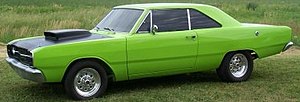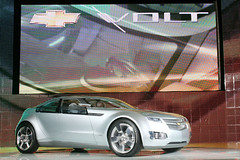 Image by Getty Images via Daylife
Image by Getty Images via Daylife
A revitalized General Motors reintroduced itself today with an array of all-new cars, crossovers and trucks debuting now through 2011. GM also made a historic announcement: When the
Chevrolet Volt extended-range electric vehicle rolls off the assembly line late next year, it will be the first mass-production automobile to achieve triple-digit fuel economy, with an expected 230 mpg in the city, or 25 kilowatt hours per 100 miles.
GM President and CEO Fritz Henderson also confirmed that Cadillac is developing an entry luxury sport sedan to capitalize on the growing market for smaller luxury sedans in the U.S. and globally. The rear- and optional all-wheel drive sedan will compete in the segment below the CTS, delivering outstanding performance and driving dynamics.
At GM’s Design Center and Milford Proving Ground, GM previewed six all-new 2010 vehicles and a glimpse of what is being introduced through the end of 2011:
- Chevrolet alone is introducing 10 new models, including the 2011 Chevrolet Volt
- Buick and GMC are adding 10 new entries, including a Buick plug-in hybrid compact crossover in 2011
- Cadillac is introducing five new models through 2011
Henderson also announced that as part of GM’s commitment to get closer to consumers, GM will use its FastLane blog to gather product research from both fans and critics. One pilot initiative, “The Lab,” will involve GM’s Advanced Design studio and allow users openly talk with designers about ideas and consumer-friendly technologies that were previously shared only in unbranded clinics.
In addition, Henderson said he and other executives plan to talk with consumers in other Web-based and in-person formats in the coming months. On Monday, the new GM executive committee, led by Henderson, showed off products and technologies to about 75 consumers at the GM Technical Center and the Milford Proving Ground.
“The key to restarting this company lies with GM’s customers, cars and culture,” Henderson said. “With four focused brands, we are committed to exceeding our current customers’ expectations and giving consumers plenty of reasons to choose a Chevy, Buick, GMC or Cadillac car or truck.”
Chevrolet Volt fuel economy achieves triple digits
Using development testing based on a draft U.S. Environmental Protection Agency (EPA) procedure for plug-in electric vehicles, the Chevrolet Volt is expected to achieve 230 miles per gallon or better in city driving (25 kW hours per 100 miles). The Volt, scheduled to begin production late next year as a 2011 model, can travel up to 40 miles on electricity from a single battery charge and can extend its overall range to more than 300 miles with its flex-fuel engine-generator.
The EPA test procedure for plug-in electric vehicles, which is still being finalized, assumes a single charge each day. According to U.S. Department of Transportation data (http://tinyurl.com/U-S-DOTStudy), nearly eight of 10 Americans commute fewer than 40 miles a day.
“From the data we’ve seen, most drivers could operate purely on grid electricity in a Chevy Volt,” Henderson said. “A car that gets more than 100 miles per gallon is a significant step in the reinvention of the auto industry and GM is and will continue to be a leader in that reinvention."
Cadillac confirms entry luxury sedan
With the all-new SRX and CTS Sport Wagon coming to market this month, the brand plans to pursue an even bigger piece of the luxury sport sedan market. Cadillac is developing a sport sedan below the acclaimed CTS that will deliver on the price of entry in this highly competitive segment of the luxury market – driving dynamics. With high-tech engines, rear-wheel drive and optional all-wheel drive, the new sedan will take on the best in the segment.
“We are determined to repeat what CTS has already achieved in design, quality, driving dynamics, performance and fuel economy to grow our presence in this high-volume and highly competitive segment,” Henderson said.
Greater customer engagement
While GM has organized customer clinics and collected feedback for many years, the Web provides even greater opportunities to connect with consumers. Henderson said executives will use a combination of in-person meetings and online technology to better interact with them.
“Our customers are the reason we’re here. It’s critical to have their voices help shape our products, and their experience with them,” Henderson said. “Their feedback helps us learn and evolve so we can continuously improve our cars and trucks, and our customer relationships.”
In addition to “Tell Fritz,” a feature on www.gmreinvention.com, in which customers can provide feedback, GM will use its popular FastLane blog (fastlane.gmblogs.com) to launch “The Lab,” a microsite featuring future projects by GM’s Advanced Design team.
Interacting directly with designers, consumers can share input on designs and technologies being considered for future projects. Those who provide detailed demographic information may be invited to participate at a deeper level in future sessions.
2010 launch vehicles by Buick, Cadillac, Chevrolet and GMC
GM’s four core brands are launching six all-new vehicles for 2010. Here’s a brand-by-brand look at what’s new:
Buick: The all-new Buick LaCrosse continues a brand renaissance begun by the Enclave luxury crossover. The LaCrosse is a completely redesigned luxury sedan that offers a sculpted exterior and luxurious cabin; advanced, intelligent personal technologies and safety features; and a choice of two fuel-saving, direct injected V-6 engines. A 2.4L four-cylinder engine joins the lineup later.
Last week, Buick announced it will introduce a compact crossover SUV next year expected to achieve more than 30 mpg on the highway, followed in 2011 by a plug-in hybrid.
Cadillac: GM’s luxury brand launches the SRX crossover and the CTS Sport Wagon into the luxury market, featuring Cadillac’s signature design and technology.
The new SRX is designed to make more inroads into the previously conservative luxury crossover category. A new, 3.0L direct injected V-6 engine is standard, and a new, 2.8L turbocharged V-6 is optional. Both feature greater fuel economy and lower emissions.
The CTS Sport Wagon is a progressive take on the classic wagon body style that delivers significant functionality and fuel efficiency, including an estimated 28 mpg highway. Essentially the same size as the acclaimed CTS sport sedan on the outside, it nearly doubles the cargo carrying capacity, with 25 cubic feet (720 liters) of space behind the rear seats and 53.4 cubic feet (1,523 liters) with the rear seat folded.
Chevrolet: The new Chevrolet Camaro returns after a seven-year hiatus. Its combination of efficient performance, which delivers up to 29 mpg highway and heritage-inspired design exemplify Chevrolet’s commitment to great design and fuel-efficiency.
The all-new Chevrolet Equinox blends distinctive design and outstanding roominess with class-leading efficiency. Chevrolet expects nearly two-thirds of customers will choose the efficient 2.4L engine – standard on all models – that delivers best-in-class EPA-rated 32 mpg highway (FWD models).
GMC: The all-new GMC Terrain crossover SUV offers outstanding fuel economy along with the capability, engineering excellence and refinement that have defined GMC for more than a century. Like other GMC vehicles, the Terrain’s design is characterized by elements that suggest muscularity, with a prominent front end and squared-off edges.
 Image via Wikipedia
Image via Wikipedia![Reblog this post [with Zemanta]](http://img.zemanta.com/reblog_e.png?x-id=bd777722-f946-46cb-acc9-cc1d21864384)

![Reblog this post [with Zemanta]](http://img.zemanta.com/reblog_e.png?x-id=2383245c-b480-43dd-aa5d-674c76818430)

![Reblog this post [with Zemanta]](http://img.zemanta.com/reblog_e.png?x-id=d31f37ea-01e9-4b2e-bdf3-05617a4b69ac)

![Reblog this post [with Zemanta]](http://img.zemanta.com/reblog_e.png?x-id=aeb1c175-7570-4f8e-a8a9-c8d8be4ea718)

![Reblog this post [with Zemanta]](http://img.zemanta.com/reblog_e.png?x-id=f6734cf4-1e4b-4fbb-adf7-a1b074a42253)

![Reblog this post [with Zemanta]](http://img.zemanta.com/reblog_e.png?x-id=4011f560-d654-44f0-a554-4e271bf3ffc5)

![Reblog this post [with Zemanta]](http://img.zemanta.com/reblog_e.png?x-id=43e28520-ae96-4859-9dae-2cfd0f2cd44f)

![Reblog this post [with Zemanta]](http://img.zemanta.com/reblog_e.png?x-id=b83cb520-bc0e-4f90-9878-e49f6fd504ff)